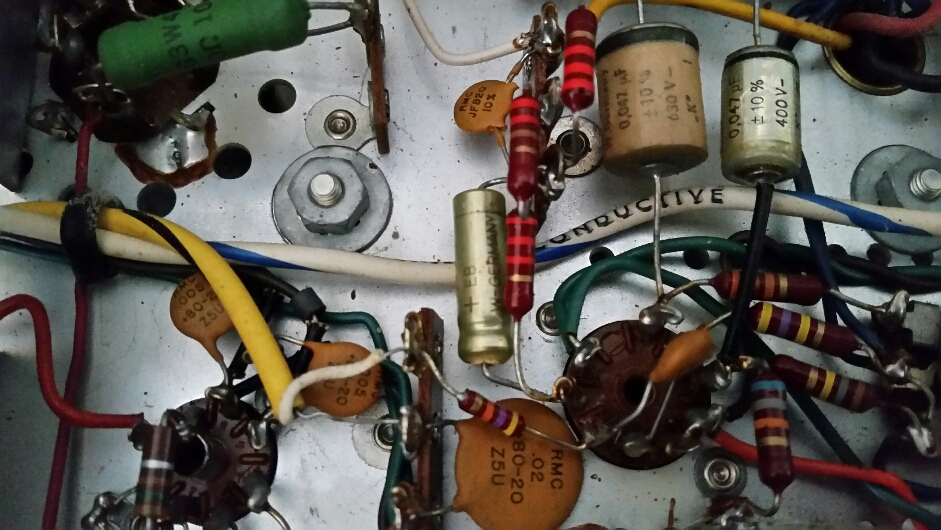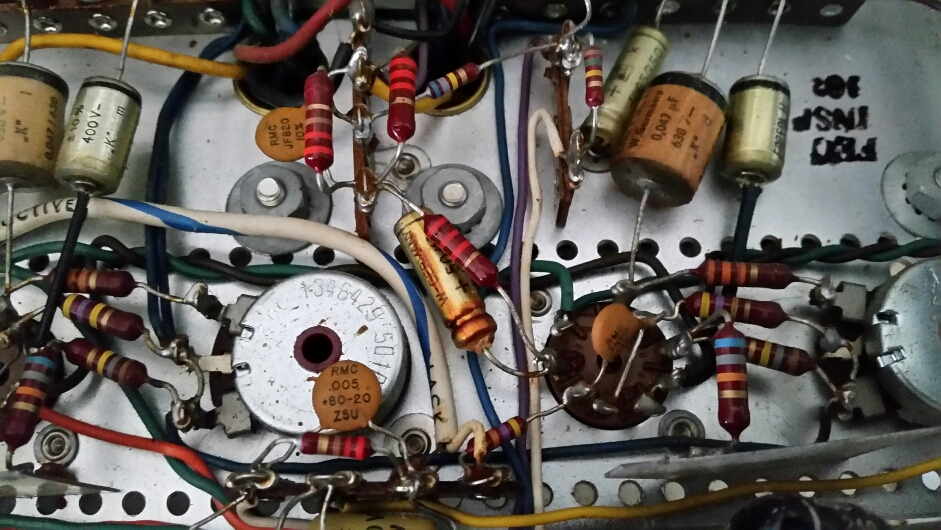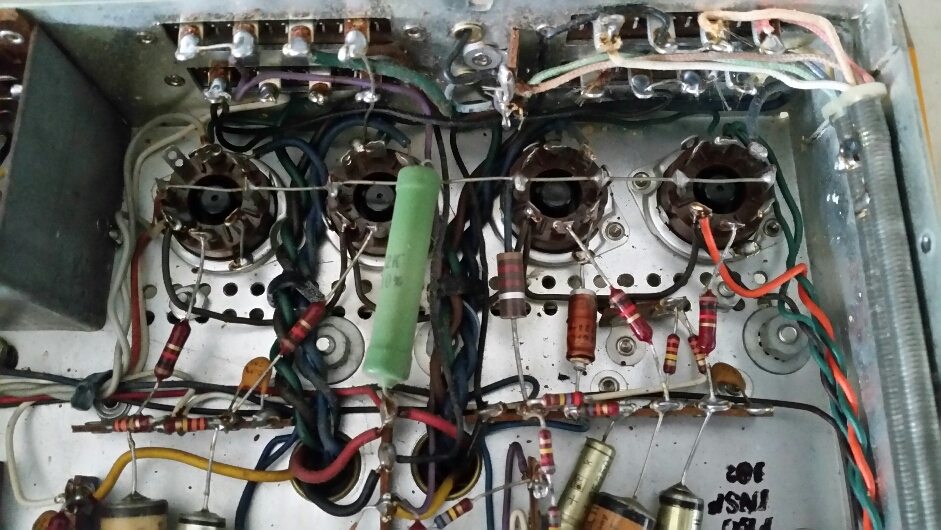Posts: 1,275
Threads: 44
Joined: Nov 2017
City: Menlo Park
State, Province, Country: CA
Got an order in today for the extra caps required. There are about 5 or so small axial electrolytics, and at least one of these looks as it has had a very hard life. Although they are from the same series, the "distressed" cap looks rather different, in a brown, overheated sort of way... Others don't seem to healthy where the leads attach. They will all be replaced.
The power switch seems to have responded to application of contact cleaner, even if this is a low voltage test compared to switching line power.
I don't hold with furniture that talks.
Posts: 1,275
Threads: 44
Joined: Nov 2017
City: Menlo Park
State, Province, Country: CA
I thought I'd have more time for this... and yet...
However, today a box of components arrived, so I now have a complete set of caps for under, and on top of the chassis. On the bench, I've been looking at the various switches for Hi, Lo, FM MPX and Tape monitor. These were super stiff, to the point I was unwilling to force them, and also made no contact. Delicate application of De-Oxit has restored a satisfying motion, and electrical operation of the contacts.
I also started sketching the wiring around the large multi cap cans, to make way for their replacement.
I don't hold with furniture that talks.
Posts: 1,275
Threads: 44
Joined: Nov 2017
City: Menlo Park
State, Province, Country: CA
Here are some pictures from under the chassis:
The gold coloured electrolytic here doesn't show any [I]outward[/] signs of trouble... but we all know that tells nothing.

In the other channel, the counterpart to above looks a little less promising, and the rubber seal around the + lead has seen better days.

This guy, who really works in the FM section, was placed near the output valves. Clearly, he's ready for replacement - at first, I had a hard time recognsing him as kin to the others!

I don't hold with furniture that talks.
Posts: 1,275
Threads: 44
Joined: Nov 2017
City: Menlo Park
State, Province, Country: CA
I got into the caps today, and replaced those pictured above, and a couple of others. There's one more axial electrolytic to replace, and then we're on to the cans 
I don't hold with furniture that talks.
Posts: 1,275
Threads: 44
Joined: Nov 2017
City: Menlo Park
State, Province, Country: CA
Oh, and I forgot.... One of the e-caps is marked as 5 uf on the parts list and .5 on the schematic. This is hard to see, as it is marked .5 not 0.5. So of course, I had ordered a 5 uf/350 V cap. Fortunately, I had a 0.47 uf film cap, which should be a good substitute.
A quick internet search revealed that this has been a trap for the unwary of many a restorer... and I fell for it as well.
I don't hold with furniture that talks.
Posts: 15,301
Threads: 532
Joined: Oct 2011
City: Jackson, NJ
Yes, 0.47uF is a good sub, and I wonder why they used electrolytic in the first place. This is 50s after all.
People who do not drink, do not smoke, do not eat red meat will one day feel really stupid lying there and dying from nothing.
Posts: 15,301
Threads: 532
Joined: Oct 2011
City: Jackson, NJ
Craig
This one:
>>>>>>With my first 500-C I just blew through and changed out everything caps wise, due primarily to lack of confidence in my own abilities compounded by internet noise
In my experience, now hindsight, that was a mistake - it altered the character of the amplifier's sound
<<<<<
I'm not sure about validity of this statement. Here's why:
1. From the point of view of the capacitors change, this is the needed procedure: old paper or bumblebee (also paper) caps are leaky as heck, I have yet to see one that isn't.
2. As for changing the amp sound: Sure!!! Changing a leaky cap to non-leaky one will change the characteristics. And, were you there to listen to it when it was first built in whatever 1950-s year? Even if you were, you wouldn't remember, but now you are likely listening to the sound that is probably is very close if not the same as the original, which has change over time as the caps became leaky/dried up and have changed the sound, and not likely in a good way, so you actually might had improved it for all I care.
It is a separate topic whether particular caps should be used and if there is a difference between different brands sound-wise, but changing them for me is not even a question.
People who do not drink, do not smoke, do not eat red meat will one day feel really stupid lying there and dying from nothing.
Posts: 1,275
Threads: 44
Joined: Nov 2017
City: Menlo Park
State, Province, Country: CA
Thanks for the contributions folks.
This receiver is Circa 1963 (date of the service notes I have). Most of the capacitors are Mylar or ceramic - there are no paper caps. I'm going to begin by assuming these are fine so fortunately, this reduces the amount of replacement necessary. Of course there are electrolytics under the chassis, and in the multi section cans - these are all in the process of being renewed.
Rather like a classic car, I want this unit to retain character, so will not be chasing major modifications beyond what is required for reliability and safety. Better control over bias, and adapting this to accommodate modern 7591 output valves will be added. Apparently there are important differences in operating characteristics.
Analogman - Thanks for your notes. I tend to agree with your comments, especially on modifications, and always try and check a few sources before considering the value of making changes. I haven't spent much time on AK, but I am familiar with the many quirky received wisdoms of HiFi. I did see the Sheldon Stokes power supply stuff, and mused on following that path for a while, until I saw the Hayseed kit.
One term you used "PEC" I am not familiar with - could you please elaborate?
Thanks again,
Ed
I don't hold with furniture that talks.
Posts: 15,301
Threads: 532
Joined: Oct 2011
City: Jackson, NJ
PEC - printed electronic circuit, a kinda predecessor to IC.
People who do not drink, do not smoke, do not eat red meat will one day feel really stupid lying there and dying from nothing.
Posts: 13,776
Threads: 580
Joined: Sep 2005
City: Ferdinand
State, Province, Country: Indiana
My two cents' worth:
I fully believe that the IBAM mod is both valid and beneficial to the set.
I also believe that adding 10 ohm resistors from the cathodes of each 7591A tube to ground is likewise valid and beneficial (and necessary for IBAM).
There is another mod for Fisher receivers using 7591A outputs which involves changing resistors and caps to different values, but I can't find it at the moment.
I have IBAM in my Fisher TA-600 and it sounds great. And I know the bias has been set to a point (34-35 mA) where the Soviet military surplus 6П14П-EB (replacements for 7189) will not self-destruct.
--
Ron Ramirez
Ferdinand IN
Posts: 1,275
Threads: 44
Joined: Nov 2017
City: Menlo Park
State, Province, Country: CA
Thanks Mike. I remember reading about them now you clarified for me... but have never seen one. Guess I should look harder, as they are under my nose LOL 
I don't hold with furniture that talks.
Posts: 1,275
Threads: 44
Joined: Nov 2017
City: Menlo Park
State, Province, Country: CA
Thank you also Ron - I think we crossed wires. IBAM is in my plans, once I get this venerable unit up and running in factory guise.
Ed
I don't hold with furniture that talks.
Posts: 15,301
Threads: 532
Joined: Oct 2011
City: Jackson, NJ
I think there are several grades of old electronics:
- those who only collect without using. They often even refuse to do absolutely anything, no refinishing, no restoration. Display only.
- those who would do minimal repair, like replacing a frayed cord. Will try to repair to a working condition but only to turn on and demo for a minute.
- those who will do full restoration to be able to use daily. There are different shades of them, from a guy who will use yellow caps openly to guys like me who will restuff old caps, to guys like Russ who will do museum quality restoration. What is common between them is that they want to be able to use the sets without them going up in flames.
If applied to stereos, to use it as daily player it has to be the latter. If there is a known flaw that potentially could result in damage, considering price of tubes or replacement transformer today, a proper mod is very desirable. And the "changes to the character" are greatly exaggerated.
People who do not drink, do not smoke, do not eat red meat will one day feel really stupid lying there and dying from nothing.
Posts: 2,118
Threads: 112
Joined: Jun 2010
City: Medford OR (OR what?)
Speaking of that, those 10 ohm 1/4W resistors can save your OP trans. and therefore saving lots of money as well as making setting bias much easier - with no downside.
"I just might turn into smoke, but I feel fine"
http://www.russoldradios.com/
Posts: 1,275
Threads: 44
Joined: Nov 2017
City: Menlo Park
State, Province, Country: CA
I'm much more in the last group of Mike's grading system. I want to make things work - I may or may not go to the lengths of re-stuffing, but a unit will be brought to full, safe working condition if it crosses my bench at all.
Stay tuned - I'll share everything done to this piece of classic audio. The work will progress in stages
Cheers
Ed
I don't hold with furniture that talks.
Users browsing this thread: 1 Guest(s)
|



